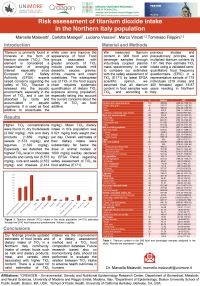Abstract
Introduction: Titanium is primarily found in minerals in the form of titanium dioxide (TiO2). This element is considered a contaminant of emerging interest especially since European Food Safety Authority (EFSA) experts raised concerns regarding the safety of TiO2 (Younes et al 2021). Titanium is released into the aquatic environment, especially in the form of TiO2 and it can be absorbed by biota, accumulating in aquatic organisms. It is used as food additive to accentuate the white color and improve the appearance of food. Food groups associated with greater amounts of TiO2 include yeast breads, milk desserts, sauces, gravies, drinks, creams and cream substitutes. The widespread use of TiO2 in the food supply chain requires systematic quantification of dietary TiO2 exposure among population, especially taking into account the current concerns about the safety of TiO2 as food additive.
Material and methods: We measured titanium content in 908 food and beverage samples through inductively coupled plasma mass spectrometry. In order to compare our estimates with the safety assessment of TiO2 (E171) by latest EFSA scientific opinion, we assumed that all titanium content in food samples was TiO2, and according to previous studies and precautionary principle, we multiplied titanium content by 1.67. We then estimate TiO2 intake using a validated semi-quantitative food frequency questionnaire (EPIC) in a representative sample of 719 individuals (319 males and 400 females) aged 18-87 years residing in Northern Italy.
Results: Higher TiO2 concentrations was found in: dry fruits/seeds (2.042 mg/kg); milk and dairy products (1.839 mg/kg); sweets (1.573 mg/kg) and legumes (1.320 mg/kg). Especially, we detected the highest TiO2 level in chocolate products and candy bar (5.573 mg/kg), nuts and seeds (2.672 mg/kg) and cheeses (2.414 mg/kg). Mean TiO2 dietary intake in this population was 0.021 mg/kg body weight (bw) per day. Overall, estimates of their dietary intake were substantially far below the dose in animal models of 1000 mg/kg bw/day declared by EFSA Panel regarding safety assessment of TiO2 as food additive (E171).
Conclusion: Our findings provide updated estimates of food levels and dietary intake of TiO2 in a Northern Italy community. Intake of certain foods such as milk and dietary products, meat, and cereals ware associated with higher TiO2 content. There is a need for valid estimation of TiO2 intakes via the improvement of a dietary assessment method and a TiO2 food composition database. Future research based also on biomonitoring data, should be performed to evaluate the relation between TiO2 intake to adverse health outcomes in humans.

